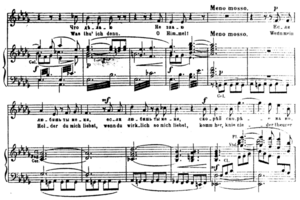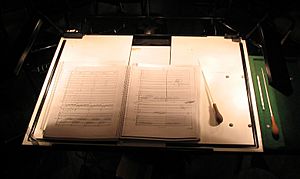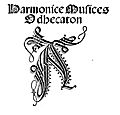Sheet music facts for kids

Sheet music is a way to write down music so musicians can read and play it. Think of it like a book for music! It's usually printed on paper and shows all the notes, rhythms, and other instructions a musician needs.
Sometimes, "sheet music" means a single song or piece printed on its own. But it can also be a collection of songs in a bigger book. When musicians play together, like a violin and piano, each musician might have their own part. The pianist's music shows their notes, usually on two lines called staves. The violinist gets a separate paper with just their violin notes. This makes it easier for each player to focus on their own part.
Contents
What is a Music Score?
A score is a special type of printed music. It shows the music for many different instruments all at once. Imagine a big page where you can see what every instrument in an orchestra is playing! Each instrument's music is written on its own stave, one above the other.
A conductor uses a score to lead an orchestra. They can see exactly what each instrument should be playing and how all the parts fit together. This helps them make sure everyone plays at the right time and sounds good as a group. Sometimes, a player might have a long break where they don't play. The score might show small notes from another instrument's part. These are called cues. They help the musician know when their turn to play is coming up!
Different Kinds of Scores
There are several types of scores, each used for different purposes:
- An orchestral score or full score shows every single instrument in an orchestra. If there are many instruments, the pages can be very tall! Conductors use these large scores to guide the orchestra during rehearsals and performances.
- A miniature score or study score is like an orchestral score, but much smaller. The print is too tiny for a conductor to use while leading. However, it's perfect for students or anyone who wants to study the music without needing a huge, expensive score.
- A vocal score or piano score is used for music with singers, like an opera or a choir piece. It takes all the music for the instruments and puts it onto two staves, so it can be played on a piano. Some notes might be left out to make it playable with just two hands.
- A short score is a simpler version of an orchestral piece. It's written on only three or four staves. Composers sometimes use short scores when they are first writing a piece. They can then create the full orchestral score later. Short scores are usually just for the composer's use and are not often published.
How Instruments Are Ordered in a Score
In an orchestral score, instruments are usually listed in a specific order from top to bottom. This helps conductors quickly find what they are looking for.
- Woodwind instruments are at the top. These include instruments like the flute, oboe, clarinet, and bassoon.
- Next come the brass instruments. This section includes the French horn, trumpet, and trombone.
- Then you'll find percussion instruments. This can be anything from claves and tambourine to a bass drum or xylophone.
- At the bottom are the string instruments. These are the violin, viola, cello, and double bass.
If there's a choir or solo singers, their part is usually placed near the bottom, just above the strings. The lines that show the measures (bar lines) often connect the staves of instruments from the same family. This makes it easier to read the score.
Standard Orchestral Order
Here is a common order for instruments in an orchestral score:
- Piccolo
- Flute
- Alto Flute
- Oboe
- Cor Anglais
- Clarinet in Eb or A
- Clarinet in Bb
- Bass Clarinet in Bb
- Alto Sax in Eb
- Bassoon
- Contrabassoons
- Horn in F
- Trumpets in Bb
- Trombones
- Bass Trombone
- Euphonium
- Tuba
- Timpani
- Other Percussion (Triangle, agogo bells, tam-tam glockenspiel, xylophone, vibraphone, tubular bells, tenor drum, bass drum)
- Other Instruments
- Harp
- Piano & Keyboards
- Choir (SATB)
- Violin 1
- Violin 2
- Viola
- Cello
- Bass
Concert Band Order
For a concert band, the instrument order is a bit different:
- Flute
- Oboe
- Bassoon
- Clarinet in Bb
- Alto Clarinet
- Bass Clarinet in Bb
- Alto Saxophone in Eb
- Tenor Saxophone in Bb
- Baritone Saxophone in Eb
- Trumpet in Bb
- Horn in F
- Trombone
- Bass Trombone
- Baritone/Euphonium
- Tuba
- Pitched Percussion
- Unpitched Percussion
Images for kids
-
Tibetan musical score from the 19th century
-
Title page for the first-edition vocal score for Hector Berlioz's Béatrice et Bénédict
-
Page from the autograph score of Fugue No. 17 in A♭ major from J. S. Bach's The Well-Tempered Clavier
-
Sheet music for the song "Oregon, My Oregon"
-
The lead sheet for the song "Trifle in Pyjamas" shows only the melody and chord symbols. To play this song, a jazz band's rhythm section musicians would improvise chord voicings and a bassline using the chord symbols. The lead instruments, such as sax or trumpet, would improvise ornaments to make the melody more interesting, and then improvise a solo part.
-
The original stone at Delphi containing the second of the two Delphic Hymns to Apollo. The music notation is the line of occasional symbols above the main, uninterrupted line of Greek lettering.
-
Buildings of New York City's Tin Pan Alley music publishing district in 1910.
See also
- Note (music)
- International Music Score Library Project, a public-domain sheet music library with original scores scanned to PDF.
 In Spanish: Partitura para niños
In Spanish: Partitura para niños











